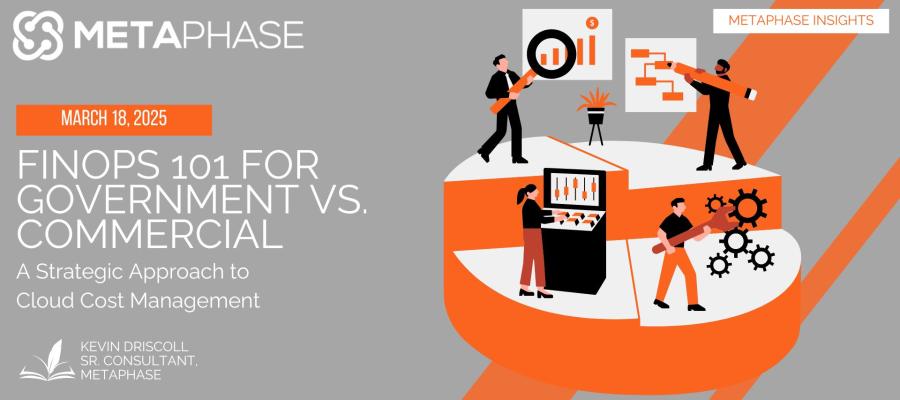
With great power comes great responsibility—especially when managing cloud costs. Cloud computing has revolutionized how organizations manage IT infrastructure, offering scalability, flexibility, and cost efficiency. However, with great power comes great responsibility, particularly in managing cloud spend. This is where FinOps (Financial Operations) comes in, providing a structured framework to optimize cloud costs while ensuring operational agility.
While FinOps principles remain the same across industries, the way they are implemented differs significantly between federal agencies and commercial enterprises. In this article, we break down the core components of FinOps and explore the unique challenges and requirements federal agencies face compared to their commercial counterparts.
FinOps 101 – Beginner’s Guide to Cloud Financial Management
At its core, FinOps is a cultural and financial practice that brings together finance, engineering, and business teams to manage cloud spending efficiently. The goal of FinOps is not just to cut costs, but to maximize the value derived from cloud investments. There are six FinOps principles for success:
- Cross-team collaboration
- Business value drives decision making
- Organization-wide sense of ownership for cloud usage
- Real-time, frictionless access to FinOps data
- Maximize the advantage of cloud cost models and elasticity/scalability
- Establish a centralized, accountable team to drive FinOps adoption and continuous improvement
Organizations using FinOps create a balance between financial accountability and agility, ensuring resources are used efficiently while supporting innovation. FinOps framework is an iterative process and operates on three key phases:
- Inform: Gaining visibility into cloud spend through cost allocation, budgeting, and forecasting.
- Optimize: Implementing strategies such as rightsizing, reserved instances, and auto-scaling to reduce unnecessary costs.
- Operate: Creating continuous processes to ensure long-term cost efficiency through governance and automation.
Federal vs. Commercial – Key Differences
While the fundamental goals of FinOps remain the same across industries, federal agencies must operate within a highly regulated environment that imposes additional constraints and considerations. Below are some of the most critical differences:
1. Budgeting & Procurement
Commercial Enterprises: Operate with flexible budgets, allowing departments to scale resources based on real-time needs. Businesses can take advantage of competitive pricing, discounts, and various cloud vendor agreements without excessive oversight.
Federal Agencies: Cloud spending must align with pre-approved budgets and procurement regulations, often tied to annual appropriations from the Planning, Programming, Budgeting, and Execution (PPBE) process. Agencies must navigate the Federal Acquisition Regulation (FAR), General Services Administration (GSA) and Technology Business Management (TBM) frameworks to justify spending, which introduces additional layers of complexity.
2. Compliance & Security
Commercial Enterprises: Security and compliance are important but largely dictated by industry best practices and corporate risk management policies.
Federal Agencies: Must comply with stringent cybersecurity frameworks such as FedRAMP, NIST 800-53, and Zero Trust Architectures. Every cloud investment must pass security assessments, and Continuous ATO (Authority to Operate) processes must be in place to ensure ongoing compliance. Additionally, agencies must factor in classified workloads and impact levels designated by CMMC (Cybersecurity Maturity Model Certification).
3. Stakeholders & Decision-Making Roles
Commercial Enterprises: Cloud financial management typically involves CFOs, CTOs, and Cloud Engineers, who make strategic cost decisions based on business needs and ROI calculations.
Federal Agencies: Decision-making is shared across multiple stakeholders, including:
- Contracting Officers (COs) & Contracting Officer Representatives (CORs): Ensure cloud costs align with contractual obligations and budget allocations.
- IT Capital Planning/Enterprise Architecture: Collaborate across budgeting, contracts, and IT to gain buy-in across the agency for IT investments and portfolio alignment.
- Chief Financial Officers (CFOs): Oversee cloud expenditures in alignment with federal spending regulations.
- Agency CIOs & CISOs: Enforce security compliance while balancing performance and cost.
- Program Managers & Mission Owners: Align cloud investments with agency objectives.
4. Optimization Strategies & Cost Controls
Commercial Enterprises: Have the flexibility to use aggressive cost-cutting measures such as spot instances, serverless computing, and multi-cloud arbitrage (switching between providers for cost efficiency). Businesses can quickly adjust spending in response to market conditions.
Federal Agencies: Must operate within strict budgetary limits and appropriations cycles. Multi-year cloud spending plans often reduce the flexibility to take advantage of short-term cost optimizations. Additionally, compliance requirements may limit the use of certain cost-saving options like spot instances, due to reliability and security concerns.
5. FinOps Tooling & Automation
Commercial Enterprises: Use a range of commercial FinOps tools such as CloudHealth, AWS Cost Explorer, and Apptio to monitor cloud usage and optimize spend dynamically.
Federal Agencies: Require tools that integrate with federal security and compliance mandates. Solutions like AWS GovCloud, Microsoft Azure Government, and Splunk Cloud for Federal provide enhanced logging, security controls, and governance tailored to government operations. Agencies may also require custom-built reporting tools that align with OMB and GAO auditing requirements.

